headlamp MITSUBISHI SHOGUN 2003 (in English) User Guide
[x] Cancel search | Manufacturer: MITSUBISHI, Model Year: 2003, Model line: SHOGUN, Model: MITSUBISHI SHOGUN 2003Pages: 392, PDF Size: 14.34 MB
Page 170 of 392
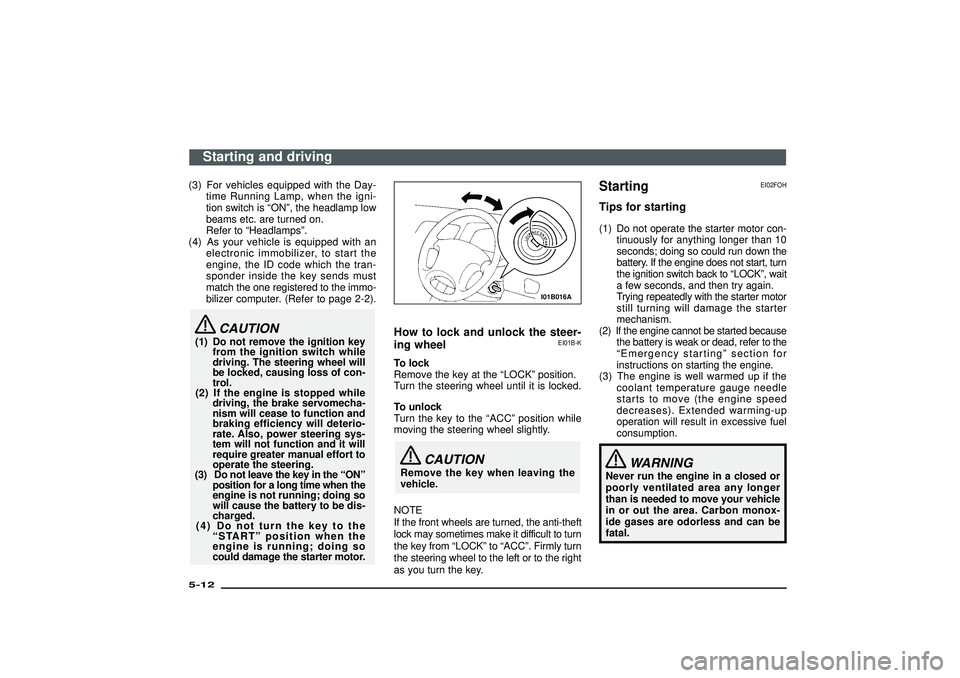
(3) For vehicles equipped with the Day-
time Running Lamp, when the igni-
tion switch is“ON”, the headlamp low
beams etc. are turned on.
Refer to“Headlamps”.
(4) As your vehicle is equipped with an
electronic immobilizer, to start the
engine, the ID code which the tran-
sponder inside the key sends must
match the one registered to the immo-
bilizer computer. (Refer to page 2-2).
CAUTION
(1) Do not remove the ignition key
from the ignition switch while
driving. The steering wheel will
be locked, causing loss of con-
trol.
(2) If the engine is stopped while
driving, the brake servomecha-
nism will cease to function and
braking efficiency will deterio-
rate. Also, power steering sys-
tem will not function and it will
require greater manual effort to
operate the steering.
(3) Do not leave the key in the“ON”
position for a long time when the
engine is not running; doing so
will cause the battery to be dis-
charged.
(4) Do not turn the key to the
“START”position when the
engine is running; doing so
could damage the starter motor.
I01B016A
How to lock and unlock the steer-
ing wheel
EI01B-K
To lock
Remove the key at the“LOCK”position.
Turn the steering wheel until it is locked.
To unlock
Turn the key to the“ACC”position while
moving the steering wheel slightly.
CAUTION
Remove the key when leaving the
vehicle.
NOTE
If the front wheels are turned, the anti-theft
lock may sometimes make it difficult to turn
the key from“LOCK”to“ACC”. Firmly turn
the steering wheel to the left or to the right
as you turn the key.
Starting
EI02FOH
Tips for starting(1) Do not operate the starter motor con-
tinuously for anything longer than 10
seconds; doing so could run down the
battery. If the engine does not start, turn
the ignition switch back to“LOCK”, wait
a few seconds, and then try again.
Trying repeatedly with the starter motor
still turning will damage the starter
mechanism.
(2) If the engine cannot be started because
the battery is weak or dead, refer to the
“Emergency starting”section for
instructions on starting the engine.
(3) The engine is well warmed up if the
coolant temperature gauge needle
starts to move (the engine speed
decreases). Extended warming-up
operation will result in excessive fuel
consumption.
WARNING
Never run the engine in a closed or
poorly ventilated area any longer
than is needed to move your vehicle
in or out the area. Carbon monox-
ide gases are odorless and can be
fatal.
Starting and driving
5-12Div:
Out put date:
Page 199 of 392
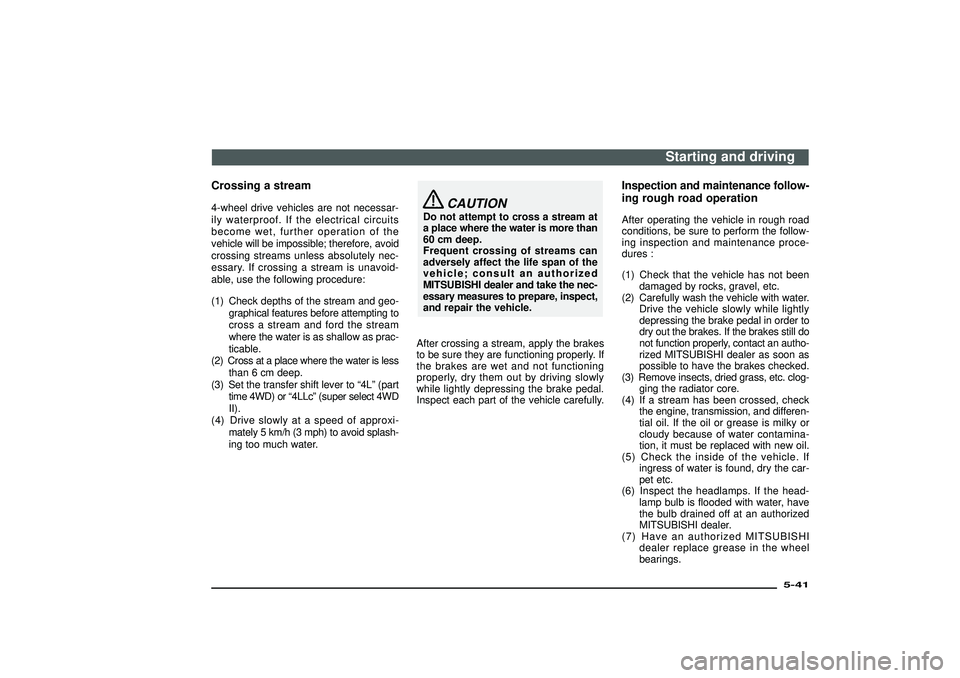
Crossing a stream4-wheel drive vehicles are not necessar-
ily waterproof. If the electrical circuits
become wet, further operation of the
vehicle will be impossible; therefore, avoid
crossing streams unless absolutely nec-
essary. If crossing a stream is unavoid-
able, use the following procedure:
(1) Check depths of the stream and geo-
graphical features before attempting to
cross a stream and ford the stream
where the water is as shallow as prac-
ticable.
(2) Cross at a place where the water is less
than 6 cm deep.
(3) Set the transfer shift lever to“4L”(part
time 4WD) or“4LLc”(super select 4WD
II).
(4) Drive slowly at a speed of approxi-
mately 5 km/h (3 mph) to avoid splash-
ing too much water.
CAUTION
Do not attempt to cross a stream at
a place where the water is more than
60 cm deep.
Frequent crossing of streams can
adversely affect the life span of the
vehicle; consult an authorized
MITSUBISHI dealer and take the nec-
essary measures to prepare, inspect,
and repair the vehicle.
After crossing a stream, apply the brakes
to be sure they are functioning properly. If
the brakes are wet and not functioning
properly, dry them out by driving slowly
while lightly depressing the brake pedal.
Inspect each part of the vehicle carefully.
Inspection and maintenance follow-
ing rough road operationAfter operating the vehicle in rough road
conditions, be sure to perform the follow-
ing inspection and maintenance proce-
dures :
(1) Check that the vehicle has not been
damaged by rocks, gravel, etc.
(2) Carefully wash the vehicle with water.
Drive the vehicle slowly while lightly
depressing the brake pedal in order to
dry out the brakes. If the brakes still do
not function properly, contact an autho-
rized MITSUBISHI dealer as soon as
possible to have the brakes checked.
(3) Remove insects, dried grass, etc. clog-
ging the radiator core.
(4) If a stream has been crossed, check
the engine, transmission, and differen-
tial oil. If the oil or grease is milky or
cloudy because of water contamina-
tion, it must be replaced with new oil.
(5) Check the inside of the vehicle. If
ingress of water is found, dry the car-
pet etc.
(6) Inspect the headlamps. If the head-
lamp bulb is flooded with water, have
the bulb drained off at an authorized
MITSUBISHI dealer.
(7) Have an authorized MITSUBISHI
dealer replace grease in the wheel
bearings.
Starting and driving
5-41
Div:
Out put date:
Page 208 of 392
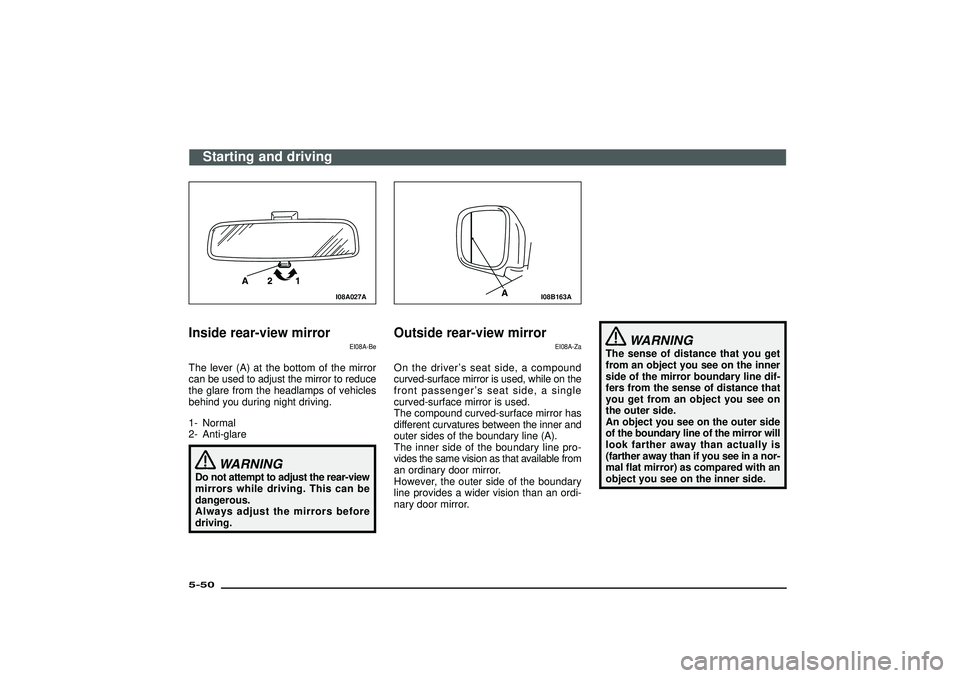
I08A027A
Inside rear-view mirror
EI08A-Be
The lever (A) at the bottom of the mirror
can be used to adjust the mirror to reduce
the glare from the headlamps of vehicles
behind you during night driving.
1- Normal
2- Anti-glare
WARNING
Do not attempt to adjust the rear-view
mirrors while driving. This can be
dangerous.
Always adjust the mirrors before
driving.
I08B163A
Outside rear-view mirror
EI08A-Za
On the driver’s seat side, a compound
curved-surface mirror is used, while on the
front passenger’s seat side, a single
curved-surface mirror is used.
The compound curved-surface mirror has
different curvatures between the inner and
outer sides of the boundary line (A).
The inner side of the boundary line pro-
vides the same vision as that available from
an ordinary door mirror.
However, the outer side of the boundary
line provides a wider vision than an ordi-
nary door mirror.
WARNING
The sense of distance that you get
from an object you see on the inner
side of the mirror boundary line dif-
fers from the sense of distance that
you get from an object you see on
the outer side.
An object you see on the outer side
of the boundary line of the mirror will
look farther away than actually is
(farther away than if you see in a nor-
mal flat mirror) as compared with an
object you see on the inner side.
Starting and driving
5-50Div:
Out put date:
Page 330 of 392
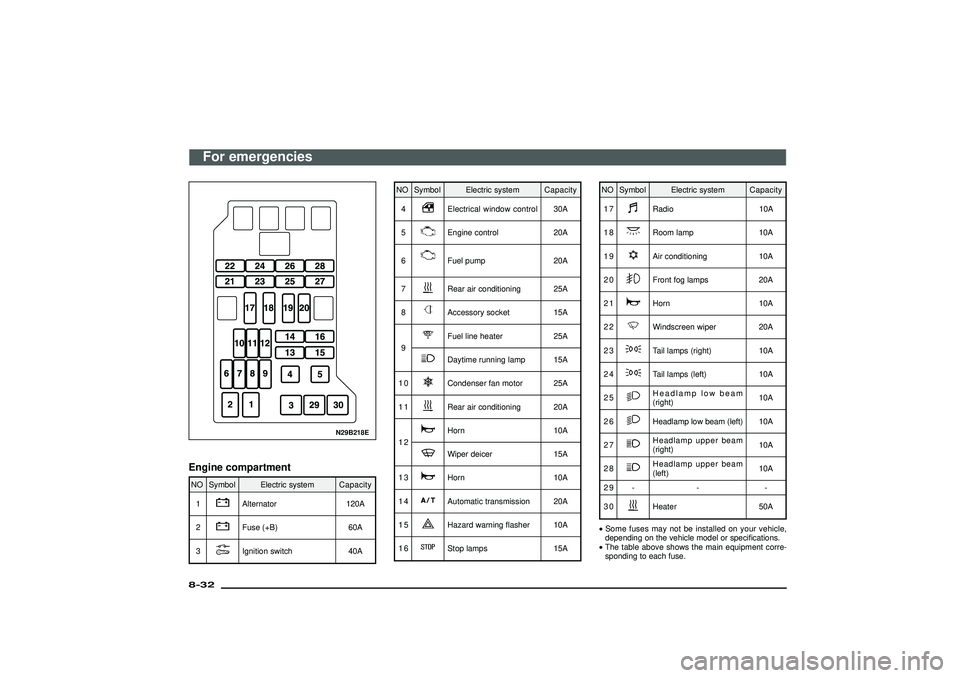
N29B218E
Engine compartmentNO Symbol Electric systemCapacity
1
Alternator 120A
2Fuse (+B) 60A
3Ignition switch 40A
NO Symbol Electric systemCapacity
4
Electrical window control 30A
5Engine control 20A
6Fuel pump 20A
7Rear air conditioning 25A
8Accessory socket 15A
9Fuel line heater 25ADaytime running lamp 15A
10Condenser fan motor 25A
11Rear air conditioning 20A
12Horn 10AWiper deicer 15A
13Horn 10A
14Automatic transmission 20A
15Hazard warning flasher 10A
16Stop lamps 15A
NO Symbol Electric systemCapacity
17
Radio 10A
18Room lamp 10A
19Air conditioning 10A
20Front fog lamps 20A
21Horn 10A
22Windscreen wiper 20A
23Tail lamps (right) 10A
24Tail lamps (left) 10A
25Headlamp low beam
(right)10A
26Headlamp low beam (left) 10A
27Headlamp upper beam
(right)10A
28Headlamp upper beam
(left)10A
29 - - -
30Heater 50A
•Some fuses may not be installed on your vehicle,
depending on the vehicle model or specifications.
•The table above shows the main equipment corre-
sponding to each fuse.
For emergencies
8-32Div:
Out put date:
Page 332 of 392

N29C001A
6. Insert a new fuse of the same capac-
ity by using the fuse puller and insert the
fuse at the same place in the fuse box.
CAUTION
(1) If the newly inserted fuse blows
again after a short time, have the
electric system checked by an
authorized MITSUBISHI dealer to
find the cause and rectify it.
(2) Never use a fuse with a capac-
ity larger than that specified or
any substitute, such as wire, foil,
etc.; doing so will cause the cir-
cuit wiring to heat up and could
cause a fire.
Replacement of lamp bulbs
EN10A-Ab
Before replacing a bulb, ensure the lamp
is off. Do not touch the glass part of the
new bulb with your bare fingers; the skin oil
left on the glass will evaporate when the
bulb gets hot and the vapor will con-
dense on the reflector and dim the sur-
face.
N10B307A
Bulb capacity
EN10BOIb
A bulb should only be replaced with a new
bulb of the same rating and type. The des-
ignation can be found on the base of the
bulb.
Outside
1- Headlamps, upper/lower beam
..................................60/55W (H4)
2- Front fog lamps*
........................... 51W(HB4)·9006
3- Front turn-signal lamps . 21W (W21W)
4- Position lamps................ 5W(W5W)
5- Side turn-signal lamps ... 5W (WY5W)
6- Side step lamps*........... 5W(WY5W)
For emergencies
8-34Div:
Out put date:
Page 333 of 392
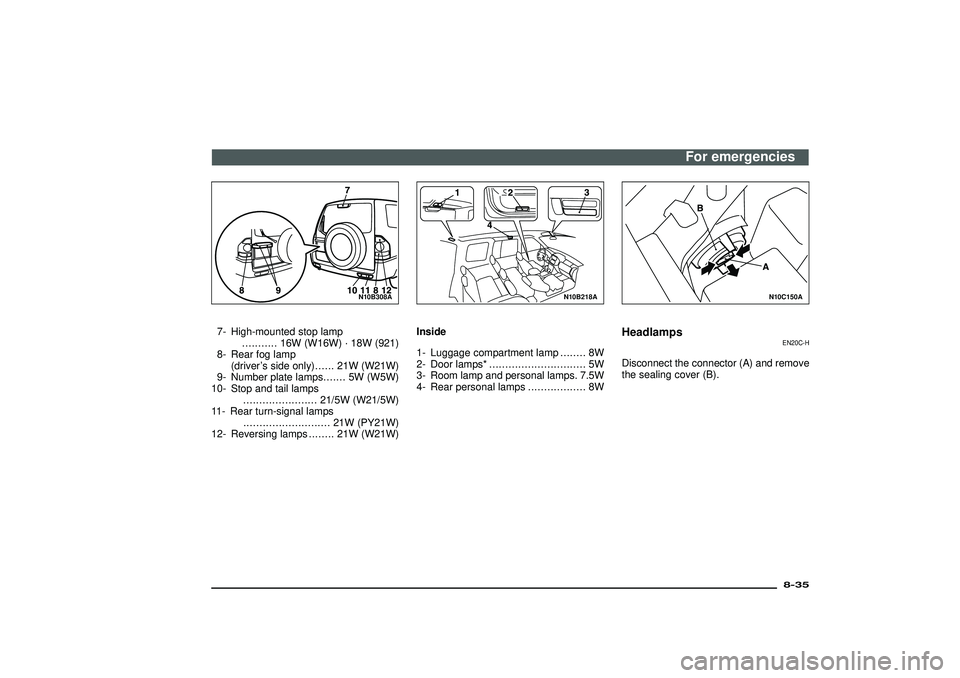
N10B308A
7- High-mounted stop lamp
........... 16W(W16W)·18W (921)
8- Rear fog lamp
(driver’s side only)...... 21W(W21W)
9- Number plate lamps....... 5W(W5W)
10- Stop and tail lamps
.......................21/5W (W21/5W)
11- Rear turn-signal lamps
........................... 21W(PY21W)
12- Reversing lamps........ 21W(W21W)
N10B218A
Inside
1- Luggage compartment lamp........ 8W
2- Door lamps*.............................. 5W
3- Room lamp and personal lamps. 7.5W
4- Rear personal lamps.................. 8W
N10C150A
Headlamps
EN20C-H
Disconnect the connector (A) and remove
the sealing cover (B).
For emergencies
8-35
Div:
Out put date:
Page 334 of 392
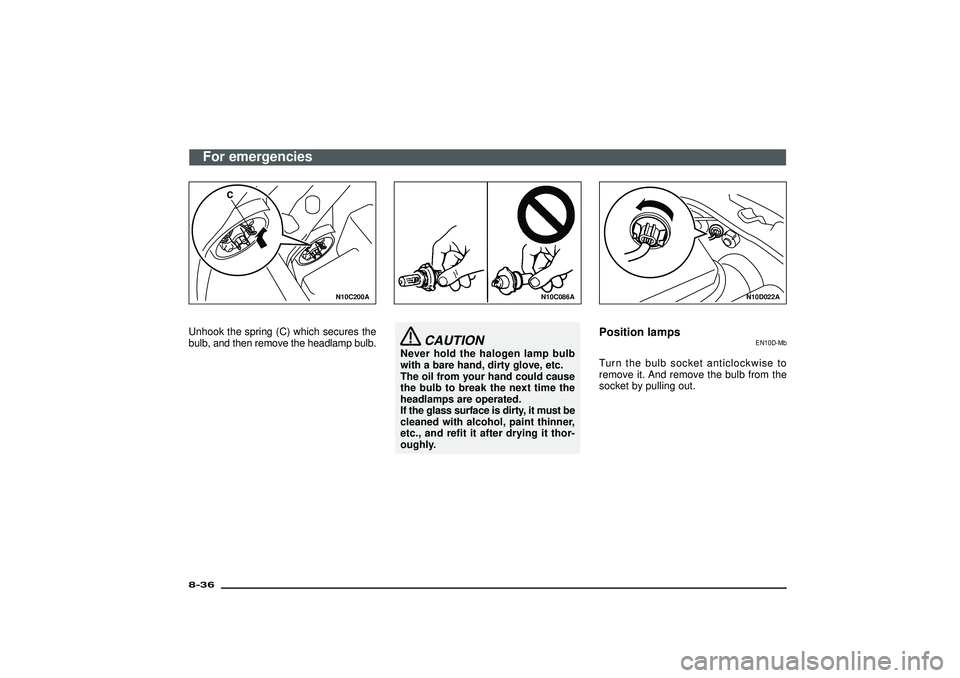
N10C200A
Unhook the spring (C) which secures the
bulb, and then remove the headlamp bulb.
N10C086A
CAUTION
Never hold the halogen lamp bulb
with a bare hand, dirty glove, etc.
The oil from your hand could cause
the bulb to break the next time the
headlamps are operated.
If the glass surface is dirty, it must be
cleaned with alcohol, paint thinner,
etc., and refit it after drying it thor-
oughly.
N10D022A
Position lamps
EN10D-Mb
Turn the bulb socket anticlockwise to
remove it. And remove the bulb from the
socket by pulling out.
For emergencies
8-36Div:
Out put date:
Page 353 of 392
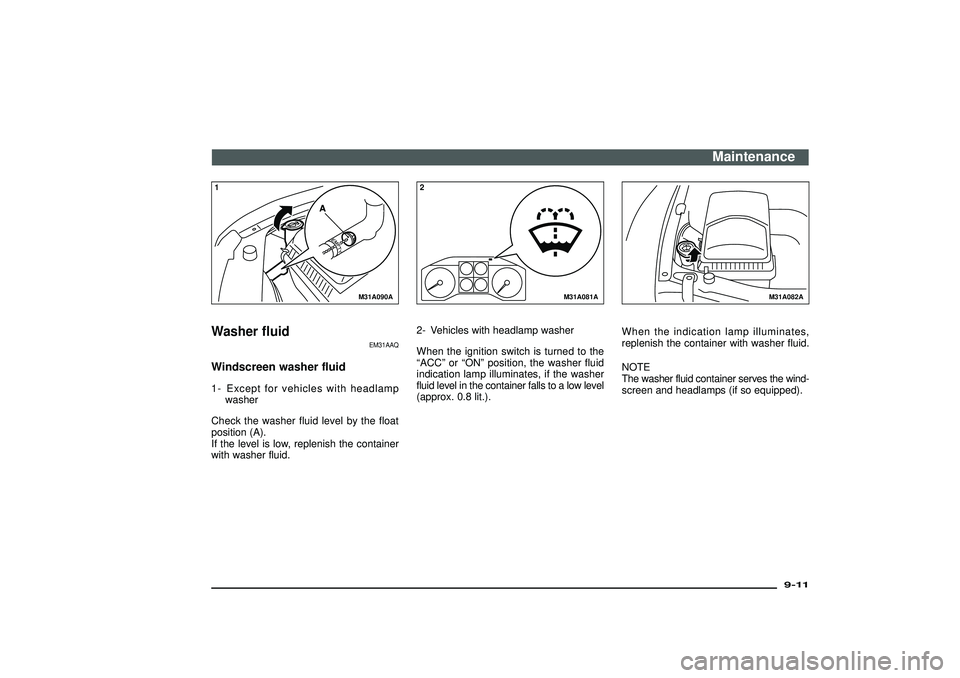
M31A090A
1Washer fluid
EM31AAQ
Windscreen washer fluid1- Except for vehicles with headlamp
washer
Check the washer fluid level by the float
position (A).
If the level is low, replenish the container
with washer fluid.
M31A081A
22- Vehicles with headlamp washer
When the ignition switch is turned to the
“ACC”or“ON”position, the washer fluid
indication lamp illuminates, if the washer
fluid level in the container falls to a low level
(approx. 0.8 lit.).
M31A082A
When the indication lamp illuminates,
replenish the container with washer fluid.
NOTE
The washer fluid container serves the wind-
screen and headlamps (if so equipped).
Maintenance
9-11
Div:
Out put date:
Page 382 of 392
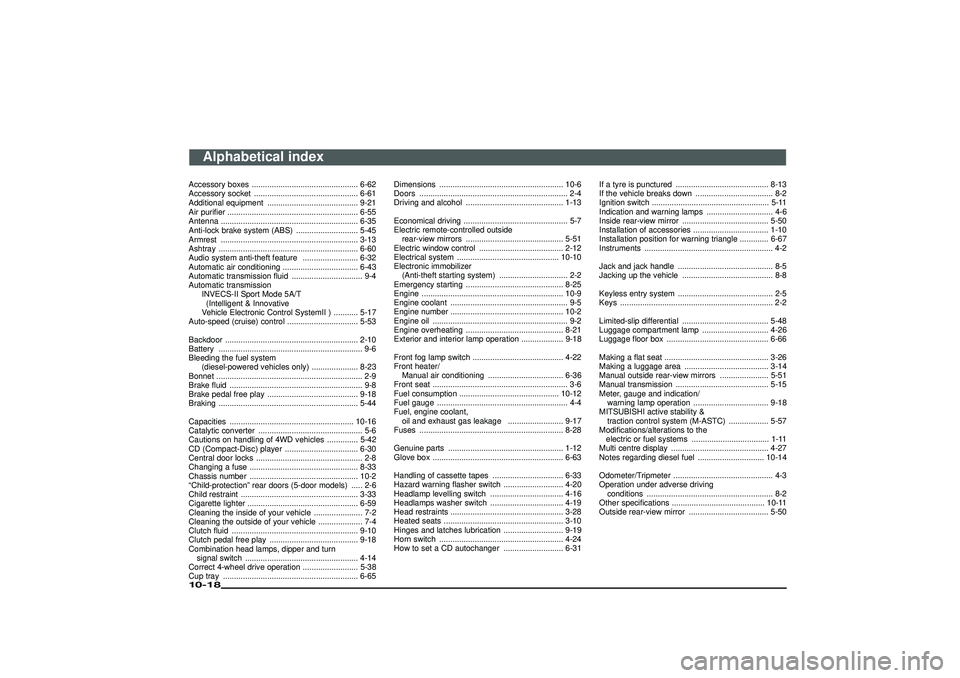
Accessory boxes ................................................ 6-62
Accessory socket ............................................... 6-61
Additional equipment ......................................... 9-21
Air purifier ........................................................... 6-55
Antenna .............................................................. 6-35
Anti-lock brake system (ABS) ............................ 5-45
Armrest .............................................................. 3-13
Ashtray ............................................................... 6-60
Audio system anti-theft feature ......................... 6-32
Automatic air conditioning .................................. 6-43
Automatic transmission fluid ................................ 9-4
Automatic transmissionINVECS-II Sport Mode 5A/T(Intelligent & Innovative
Vehicle Electronic Control SystemII ) ........... 5-17
Auto-speed (cruise) control ................................ 5-53
Backdoor ............................................................ 2-10
Battery ................................................................. 9-6
Bleeding the fuel system (diesel-powered vehicles only) ..................... 8-23
Bonnet .................................................................. 2-9
Brake fluid ............................................................ 9-8
Brake pedal free play ......................................... 9-18
Braking ............................................................... 5-44
Capacities ........................................................ 10-16
Catalytic converter ............................................... 5-6
Cautions on handling of 4WD vehicles .............. 5-42
CD (Compact-Disc) player ................................. 6-30
Central door locks ................................................ 2-8
Changing a fuse ................................................. 8-33
Chassis number ................................................. 10-2
“Child-protection” rear doors (5-door models) ..... 2-6
Child restraint ..................................................... 3-33
Cigarette lighter .................................................. 6-59
Cleaning the inside of your vehicle ...................... 7-2
Cleaning the outside of your vehicle .................... 7-4
Clutch fluid ......................................................... 9-10
Clutch pedal free play ........................................ 9-18
Combination head lamps, dipper and turn signal switch ................................................... 4-14
Correct 4-wheel drive operation ......................... 5-38
Cup tray ............................................................. 6-65 Dimensions ........................................................ 10-6
Doors ................................................................... 2-4
Driving and alcohol ............................................ 1-13
Economical driving ............................................... 5-7
Electric remote-controlled outside
rear-view mirrors ............................................ 5-51
Electric window control ...................................... 2-12
Electrical system .............................................. 10-10
Electronic immobilizer (Anti-theft starting system) ............................... 2-2
Emergency starting ............................................ 8-25
Engine ................................................................ 10-9
Engine coolant ..................................................... 9-5
Engine number ................................................... 10-2
Engine oil ............................................................. 9-2
Engine overheating ............................................ 8-21
Exterior and interior lamp operation ................... 9-18
Front fog lamp switch ......................................... 4-22
Front heater/ Manual air conditioning .................................. 6-36
Front seat ............................................................. 3-6
Fuel consumption ............................................. 10-12
Fuel gauge ........................................................... 4-4
Fuel, engine coolant, oil and exhaust gas leakage ......................... 9-17
Fuses ................................................................. 8-28
Genuine parts .................................................... 1-12
Glove box ........................................................... 6-63
Handling of cassette tapes ................................ 6-33
Hazard warning flasher switch ........................... 4-20
Headlamp levelling switch ................................. 4-16
Headlamps washer switch ................................. 4-19
Head restraints ................................................... 3-28
Heated seats ...................................................... 3-10
Hinges and latches lubrication ........................... 9-19
Horn switch ........................................................ 4-24
How to set a CD autochanger ........................... 6-31 If a tyre is punctured .......................................... 8-13
If the vehicle breaks down ................................... 8-2
Ignition switch ..................................................... 5-11
Indication and warning lamps .............................. 4-6
Inside rear-view mirror ....................................... 5-50
Installation of accessories .................................. 1-10
Installation position for warning triangle ............. 6-67
Instruments .......................................................... 4-2
Jack and jack handle ........................................... 8-5
Jacking up the vehicle ......................................... 8-8
Keyless entry system ........................................... 2-5
Keys ..................................................................... 2-2
Limited-slip differential ....................................... 5-48
Luggage compartment lamp .............................. 4-26
Luggage floor box .............................................. 6-66
Making a flat seat ............................................... 3-26
Making a luggage area ...................................... 3-14
Manual outside rear-view mirrors ...................... 5-51
Manual transmission .......................................... 5-15
Meter, gauge and indication/
warning lamp operation .................................. 9-18
MITSUBISHI active stability & traction control system (M-ASTC) .................. 5-57
Modifications/alterations to the electric or fuel systems ................................... 1-11
Multi centre display ............................................ 4-27
Notes regarding diesel fuel .............................. 10-14
Odometer/Tripmeter ............................................. 4-3
Operation under adverse driving conditions ......................................................... 8-2
Other specifications .......................................... 10-11
Outside rear-view mirror .................................... 5-50
Alphabetical index
1
0-18Div:
Out put date: